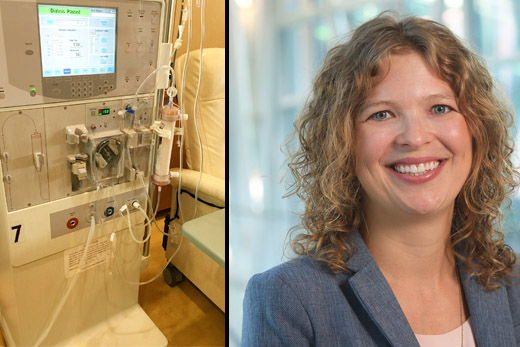Patients with end-stage kidney disease who receive dialysis at for-profit dialysis centers are less likely to receive a kidney transplant than patients receiving dialysis at non-profit dialysis centers, according to researchers at Emory University and Kaiser Permanente Center for Research and Evaluation in Georgia. The results of this retrospective study of more than 1.4 million patients was published today in the Sept. 10, 2019 issue of the Journal of the American Medical Association (JAMA).
“Several decades ago, research showed that for-profit dialysis facilities had lower kidney transplantation rates,” says Rachel Patzer, PhD, MPH, associate professor in the Departments of Surgery and Medicine, Emory University School of Medicine, and senior author on the JAMA paper. “We wanted to determine if the association between dialysis facility ownership and transplant access has persisted over time. In addition, no prior studies had examined whether for-profit facilities also had lower rates of living donor and deceased donor transplantation rates.”
Using the publicly-available national United States Renal Data System (USRDS), the researchers reviewed retrospective records of 1,478,564 patients with end-stage kidney disease (ESKD) at 6,511 U.S. dialysis facilities between January 2000 and December 2016. The USRDS collects information on U.S. patients with ESKD at the time patients begin long-term dialysis or receive a kidney transplant. The USRDS is also linked to the United Network for Organ Sharing data, which includes data on national waitlisting for transplantation and all transplant events in the nation. Dialysis facility-level data from Dialysis Facility Compare, which reports the facility’s profit status and corporate ownership, and Dialysis Facility Report, which reports treatment patterns and transplantation rates, were also used in this study.
The study included review of non-profit small chains, non-profit independent facilities, for-profit large chains (greater than 1000 facilities), for-profit small chains (less than 1000 facilities) and for-profit independent facilities, with 87 percent of patients receiving care at for-profit dialysis facilities.
The researchers determined that over the 17-year study period, patients receiving care in for-profit facilities vs. non-profit facilities had significantly lower waitlisting, where 11.9 percent of ESKD patients receiving care in non-profit small chain facilities were waitlisted for a kidney transplant, while 29.8 percent of patients receiving care in non-profit independent dialysis facilities were waitlisted. This is compared to 7.0 percent in one for-profit large chain, 6.2 percent in another for-profit large chain, 6.6 percent in for-profit small chains and 6.9 percent in for-profit independent facilities.
There was also a lower percentage of patients in all for-profit facilities who received a living donor kidney transplant (1.3 percent) or deceased donor kidney transplant (2.7 percent) compared to all non-profit facilities (3.5 percent and 7.6 percent, respectively). The disparity in access to waitlisting as well as living and deceased donor transplant persisted every year.
“For-profit dialysis facilities have a higher profit margin when they have more patients on dialysis,” says Patzer. “In non-profit facilities, there is not the same emphasis on profit margins. We hypothesize that this leads to fewer referrals for transplant among for-profit dialysis facilities, which may explain why there is a higher rate of waitlisting and living donor transplants among non-profit facilities compared to for-profit dialysis facilities. In addition, prior research has shown that providers in for-profit facilities are less likely to spend time educating and counseling patients about transplantation.”
More research is needed to better understand the reasons behind the findings.
“The limitations for the study include the inability to measure the number of staff used to educate patients about kidney transplantation, staffing resources and transplant referral practices, all of which may be associated with increased access to kidney transplant,” says Jennifer Gander, PhD, an investigator at the Kaiser Permanente Center for Research and Evaluation in Georgia. Gander was a post-doctoral fellow working with Patzer at Emory University, who continued working on the research project when she was employed by Kaiser Permanente. “It was also difficult to determine if patients had been evaluated for transplant or received a referral for transplant evaluation, as it is challenging to capture steps in the transplantation process before a patient is waitlisted or before they receive a kidney transplant.”
To address some of these limitations, Patzer and her research team have developed a regional registry to measure referral from a dialysis facility to a transplant center, and have plans to expand this nationally to better understand referral patterns by facility ownership.
Whether patients receive dialysis in a for-profit or non-profit dialysis facility, there is one important message the researchers want to pass along.
“Patients should advocate for themselves, and ask questions about all treatment options, including transplantation,” says Patzer. “Not all patients are candidates for transplant, but patients should make sure to have these conversations with their medical providers to understand the risks, benefits and steps needed to pursue kidney transplantation as a treatment option.”
This study was supported in part by a grant from the National Institutes of Diabetes and Digestive and Kidney Diseases (F32DK1071910), grants from the National Institute on Minority Health and Health Disparities (R01MD010290 and U01MD010611) and grants from the National Centers for Advancing Translational Sciences (UL1TR002378 and TL1TR002382).

